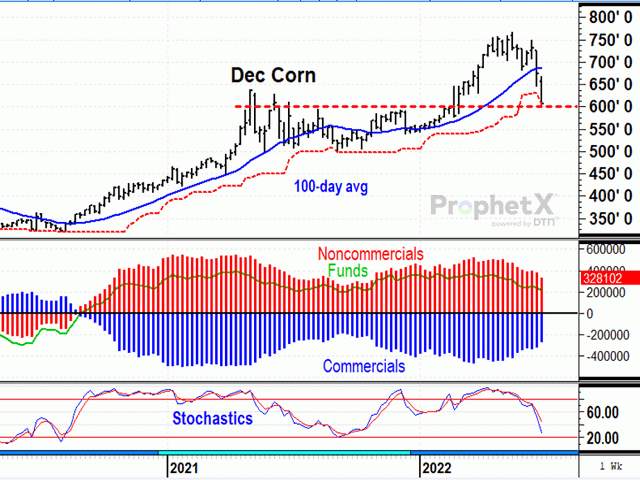Technically Speaking
Tide Turns in December Corn
December corn fell 66 1/2 cents in the latest week, a second big weekly drop that took prices from $7.31 on June 17 to $6.07 1/2 on July 1, the lowest close in four months. The sudden drop in altitude was unexpected and largely the result of heavy noncommercial selling, related to worries about rising interest rates and talk of a possible recession. An introduction of rain in the forecast for the northern Corn Belt in early July added to the selling pressures. Trading momentum is clearly down, but with plenty of uncertainty left in the crop season, support should be near. One possible source of support for December corn is $6.00, a level that was resistance in the second half of 2021. Noncommercial net longs in corn have dropped 35% the past two weeks but are still sizeable at 328,102 contracts.
SPRING WHEAT:September Minneapolis wheat fell $1.22 1/2 to $9.48 in the week ended July 1, the lowest close in four months and down $4.58 1/2 from the May 17 peak of $14.06 1/2. Noncommercial net longs in Minneapolis wheat have been cut by over half the past two months, spooked out initially by talk of Russia allowing Ukraine to export grain and then by investor fears about the economy. The dramatic sell-off has obviously turned the trend down and, like December corn above, prices have fallen back to roughly $9.50, the former level of resistance in the second half of 2021. Noncommercials are still net long 11,658 contracts as of June 28 and the future of world wheat supplies is still questionable in 2022. The weekly stochastic indicator is also sharply lower, but there is no visible sign of support yet.
P[L1] D[0x0] M[300x250] OOP[F] ADUNIT[] T[]
September KC wheat fell 84 3/4 cents to $9.13 1/2 in the week ended July 1, also posting its lowest close in four months. As with the two above, the selling was largely related to investor concerns about the economy, more than anything about wheat itself. After falling in six of the past seven weeks, the weekly stochastic is in oversold territory, but noncommercials are still net long 21,163 contracts, a possible source of more selling. Fundamentally, however, U.S. wheat supplies are expected to be as tight in 2022-23 as they were in 2021-22. Early in 2022, September KC wheat had resistance at $8.66 1/2, a possible source of support, if prices fall that far. For now, trading momentum is down and there is no sign of support yet.
**
Comments above are for educational purposes only and are not meant as specific trade recommendations. The buying and selling of grain or grain futures or options involve substantial risk and are not suitable for everyone.
Todd Hultman can be reached at Todd.Hultman@dtn.com
Follow him on Twitter @ToddHultman1
(c) Copyright 2022 DTN, LLC. All rights reserved.






Comments
To comment, please Log In or Join our Community .